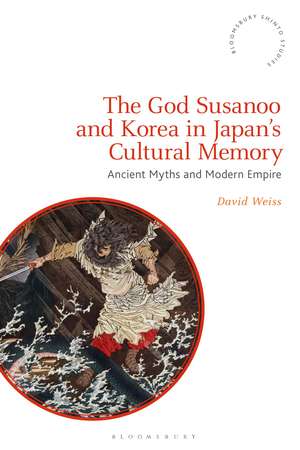The God Susanoo and Korea in Japan’s Cultural Memory: Ancient Myths and Modern Empire: Bloomsbury Shinto Studies
Autor David Weissen Limba Engleză Paperback – 23 aug 2023
| Toate formatele și edițiile | Preț | Express |
|---|---|---|
| Paperback (1) | 191.85 lei 6-8 săpt. | |
| Bloomsbury Publishing – 23 aug 2023 | 191.85 lei 6-8 săpt. | |
| Hardback (1) | 540.23 lei 6-8 săpt. | +115.58 lei 7-11 zile |
| Bloomsbury Publishing – 12 ian 2022 | 540.23 lei 6-8 săpt. | +115.58 lei 7-11 zile |
Preț: 191.85 lei
Nou
36.71€ • 39.87$ • 30.84£
Carte tipărită la comandă
Livrare economică 22 aprilie-06 mai
Specificații
ISBN-10: 1350271217
Pagini: 256
Dimensiuni: 156 x 234 x 25 mm
Greutate: 0.36 kg
Editura: Bloomsbury Publishing
Colecția Bloomsbury Academic
Seria Bloomsbury Shinto Studies
Locul publicării:London, United Kingdom
Caracteristici
Notă biografică
Cuprins
Recenzii
David Weiss has tackled the long overdue task of heaping Amaterasu's 'shady' brother out of the shadows, arguing for his importance not only in Japanese mythology and Shinto, but also for political purposes under Japanese Imperialism. Uncovering the 'Korean link' of Susanoo together with his representations and interpretations not only benefits scholars, but it also supplies under- and postgraduate students with an authoritative introduction to Susanoo and the diverse roles he plays in Japan's cultural memory.
Descriere
This book is available as open access through the Bloomsbury Open Access programme and is available on www.bloomsburycollections.com.This book discusses how ancient Japanese mythology was utilized during the colonial period to justify the annexation of Korea to Japan, with special focus on the god Susanoo. Described as an ambivalent figure and wanderer between the worlds, Susanoo served as a foil to set off the sun goddess, who played an important role in the modern construction of a Japanese national identity. Susanoo inhabited a sinister otherworld, which came to be associated with colonial Korea. Imperialist ideologues were able to build on these interpretations of the Susanoo myth to depict Korea as a dreary realm at the margin of the Japanese empire that made the imperial metropole shine all the more brightly. At the same time, Susanoo was identified as the ancestor of the Korean people. Thus, the colonial subjects were ideologically incorporated into the homogeneous Japanese "family state".The book situates Susanoo in Japan's cultural memory and shows how the deity, while being repeatedly transformed in order to meet the religious and ideological needs of the day, continued to symbolize the margin of Japan.








